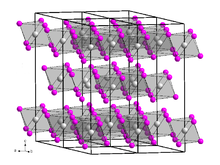Terbium(III) bromide
Jump to navigation
Jump to search

| |
| Names | |
|---|---|
| Other names
terbium tribromide
| |
| Identifiers | |
3D model (JSmol)
|
|
| ECHA InfoCard | 100.034.932 |
| EC Number |
|
PubChem CID
|
|
CompTox Dashboard (EPA)
|
|
| |
| |
| Properties | |
| TbBr3 | |
| Molar mass | 398.637 g/mol |
| Appearance | white powder (hexahydrate)[1] |
| Density | 4.62 g/cm3[2] |
| Melting point | 827[3] °C (1,521 °F; 1,100 K) |
| Boiling point | 1,490[4] °C (2,710 °F; 1,760 K) |
| soluble[4] | |
| Hazards | |
| GHS labelling: | |

| |
| Warning | |
| H315, H319, H335 | |
| P261, P264, P271, P280, P302+P352, P304+P340, P305+P351+P338, P312, P321, P332+P313, P337+P313, P362, P403+P233, P405, P501 | |
Except where otherwise noted, data are given for materials in their standard state (at 25 °C [77 °F], 100 kPa).
| |
Terbium(III) bromide (TbBr3) is a crystalline chemical compound.[5]
Production and properties
Terbiun(III) bromide can be produced by heating terbium metal or terbium(III) oxide with ammonium bromide.[6]
- Tb2O3 + 6 NH4Br → 2 TbBr3 + 6 NH3 + 3 H2O
Solution of terbium(III) bromide can crystallize its hexahydrate. When heating it, it will dehydrate and produce some TbOBr.[7]
Terbium(III) bromide is a white solid that soluble in water.[4] It's crystal structure is same as bismuth iodide.[8]
References
- ^ D. Brown, S. Fletcher, D. G. Holah (1968). "The preparation and crystallographic properties of certain lanthanide and actinide tribromides and tribromide hexahydrates". Journal of the Chemical Society A: Inorganic, Physical, Theoretical: 1889–1894. doi:10.1039/j19680001889. ISSN 0022-4944. Retrieved 2020-05-29.
{{cite journal}}: CS1 maint: multiple names: authors list (link) - ^ americanelements.com: Terbium Bromide
- ^ Sigma-Aldrich Co., product no. 466344.
- ^ a b c CRC Handbook of Chemistry and Physics, 87th Edition, S. 4–94
- ^ "Terbium(III) bromide".
- ^ Gerd Meyer, Siegfried Dötsch, Thomas Staffel (January 1987). "The ammonium-bromide route to anhydrous rare earth bromides MBr3". Journal of the Less Common Metals. 127: 155–160. doi:10.1016/0022-5088(87)90372-9. Retrieved 2020-05-29.
{{cite journal}}: CS1 maint: multiple names: authors list (link) - ^ I. Mayer, S. Zolotov (September 1965). "The thermal decomposition of rare earth and yttrium bromide hydrates". Journal of Inorganic and Nuclear Chemistry. 27 (9): 1905–1909. doi:10.1016/0022-1902(65)80042-2. Retrieved 2020-05-29.
- ^ Jean D'Ans, Ellen Lax (1997). Taschenbuch für Chemiker und Physiker. Springer DE. p. 1386. ISBN 354060035-3.
Categories:
- CS1 maint: multiple names: authors list
- Chemical pages without ChemSpiderID
- Articles without EBI source
- Articles without KEGG source
- Articles without UNII source
- ECHA InfoCard ID from Wikidata
- Chembox having GHS data
- Articles containing unverified chemical infoboxes
- Articles with short description
- Short description matches Wikidata
- Bromides
- Terbium compounds
- Lanthanide halides
- All stub articles
- Inorganic compound stubs